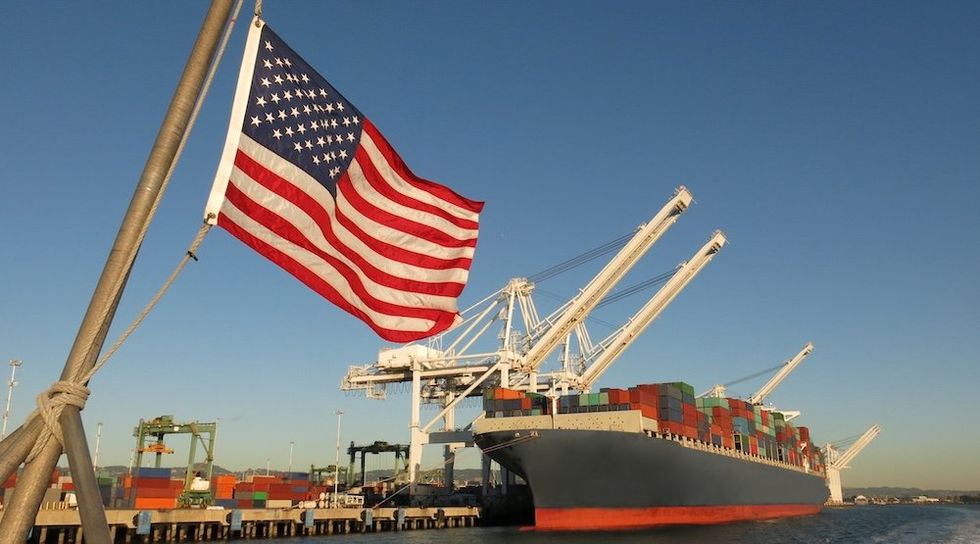President Donald Trump blasted India with 50% tariffs, which are set to take effect August 27. These tariffs reflect Trump’s instinct that India is becoming the next China — and he’s spot-on.
Unfortunately, the tariffs will do little to stop this. Why? Because India isn’t coming for our manufacturing. They’re coming for our technology sector — and they’ve been remarkably successful both at scooping up jobs and flying under the radar.
Bangalore is booming. Boston is becoming a bust. What’s going on?
Since 2001, America has lost roughly 5 million jobs to China. During the same period, America lost up to 4 million technology jobs to India. Moreover, India now has access to sensitive American technology and information.
This is beyond an economic issue; it’s a silent national emergency.
If we are serious about reshoring American industry, then tariffs on Indian products won’t cut it. We should also tariff Indian services.
Made in Mumbai
India’s technology industry is bustling. In 2024, technology made up approximately 7% of India’s GDP. The industry employs 5.4 million people and added 126,000 new jobs last year alone. Revenue was up 5.1% year over year.
Technology is transforming India. Cities like Bangalore boast newly minted billionaires and skyscrapers. Meanwhile, technology employment in many major American cities, like Boston, is stagnating.
Bangalore is booming. Boston is becoming a bust. What’s going on?
One word: offshoring.
Increasingly, American companies are moving their production of digital services to India. Why? Because Indian labor is cheap. Consider that the average American technology worker earns $110,000 per year. Meanwhile, their Indian counterparts earn about $32,000 — Indians work for one-third the price.
Why hire an American when you can hire an Indian to do the same job for a fraction of the price?
Offshoring explains the rapid growth of India’s technology sector, 80% of which comes from exports alone — far more than China at the same stage of its rise in 2001.
Interestingly, America’s trade deficit in services with India was just $3.2 billion — fairly small when compared with other countries. This has given the false impression that offshoring is not a problem.
The reality is much more grim. The scale of offshoring is obscured by the fact that Indian services — which are largely “branch plants” of American technology companies — also service non-American markets.
RELATED: Why tariffs beat treaties in a world that cheats
 Amy Laughinghouse via iStock/Getty Images
Amy Laughinghouse via iStock/Getty Images
America’s tech giants rake in large profits by offshoring production to India. In turn, India’s government collects the tax revenue, and Indian people benefit from new jobs. But as usual, the American people don’t factor into this equation — yet another example of Wall Street screwing over ordinary Americans.
The price of a rupee
In my book “Reshore: How Tariffs Will Bring Our Jobs Home and Revive the American Dream,” I explain how offshoring hurts American workers in three main ways.
First, it relocates American jobs abroad, causing unemployment. Second, it suppresses wages by flooding the labor market with laid-off workers and by putting Americans in direct wage competition with cheaper foreign workers. Third, it redirects investment — especially in education — from the United States to India.
How many technology jobs have been lost to India? Although the exact number is impossible to calculate, we can estimate. A good starting point is to look at the number of Indian jobs supported by U.S. dollars. Remember, 5.4 million Indians work in the technology sector, and 80% of the revenue comes from exports — mostly purchased by the United States.
Why hire an American when you can hire an Indian to do the same job, for a fraction of the price?
If we assume a one-to-one corollary between an Indian job and an American job, then we can guess that 4.3 million jobs have been displaced. In reality, this is probably too generous — Americans are more productive than their Indian counterparts. Either way, the number of lost jobs are in the millions.
And those job losses ripple through the labor market.
Displaced workers compete for fewer domestic jobs, driving down wages. At the same time, employers can offshore tech services to India with ease, which drags wages down further.
It’s a global race to the bottom — and American workers have the farthest to fall.
Offshoring more than jobs
But an even more nefarious cost of offshoring hits directly at our kids’ futures. Offshoring reduces the demand for skilled labor in America and increases it in India, incentivizing investment ineducation abroad while neglecting our own schools. It’s not only cheaper to hire Indians, it’s also cheaper to train them.
The proof is in the pudding. In 2004, 51,000 Americans graduated with computer science degrees and 4,000 in software engineering. By 2024, these numbers had doubled to approximately 100,000 and 8,000 respectively — not bad.
RELATED: Read it and weep: Tariffs work, and the numbers prove it
 GCShutter via iStock/Getty Images
GCShutter via iStock/Getty Images
However, when compared to India, 80,000 Indian students graduated with computer science degrees in 2004 and 5,000 in software engineering. By 2024, these numbers had tripled to over 250,000 and 15,000 respectively. Despite having a much smaller technology industry that is entirely dependent on American investment, India now trains more people for the technology industry than the country that hires them — and the number of graduates is increasing faster.
American technology companies demand educated Indians rather than educated Americans. As such, major American technology companies pour money into Indian universities.
Bring services back home
The United States has been pillaged for decades. The inability to manufacture basic goods poses a stark threat to the nation. The same is increasingly true of technology services: Americans are taking the back seat in education, employment, and innovation.
President Trump’s instincts on tariffs are correct, but regarding India, the reality is that tariffs are akin to fighting last year’s war. We need to either tariff offshored services or tax the wages paid to foreigners so that there is no cost advantage to hiring Indians (or anyone else). If not, America will depend on foreigners for goods and services — and there will be nothing left at home.
Click this link for the original source of this article.
Author: Spencer P. Morrison
This content is courtesy of, and owned and copyrighted by, http://theblaze.com and its author. This content is made available by use of the public RSS feed offered by the host site and is used for educational purposes only. If you are the author or represent the host site and would like this content removed now and in the future, please contact USSANews.com using the email address in the Contact page found in the website menu.







